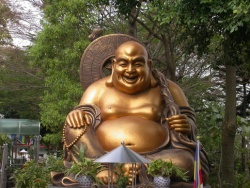Eminent monks: translators, teachers, and travellers
The first monks in China all were foreigners, the first Chinese clerics are found from the 4th century on. An Shigao 安世高 (mid 2nd cent.) was the first translator of Buddhist sutras (chin.: jing 經) from Sanskrit (chin.: Fan 梵) into Chinese. During the Jin Dynasty, the teaching of prajna ("sage wisdom") became prevalent, manifested in the sutra Prajnaparamita ("Perfection of wisdom"), translated by Dharmaraksha (chin.: Zhu Fahu 竺法護) in 291. Other representatives of this school were Zhi Dun 支盾 (d. 366) and Xi Chao 郗超 (d. 377). The 4th and 5th century brought up a number of famous monks of Chinese and Non-Chinese origin who tried to translate accurately Buddhist sutras into Chinese and to make the early translations free from Taoist tought and terms: Fotu Cheng 佛圖澄 (d. 349), Kumarajiva 鳩摩羅什 (413), Faxian 法顯 who travelled in 399 to India to bring back the whole corpus of Vinaya texts "Rules of Discipline" (chin.: lü 律) and translated them into Chinese, Daoan 道安 (d. 385) who compiled a catalogue of sutras and promoted the Maitreya cult, Huiyuan 慧遠 (d. 416) who promoted the Amitabha cult and together with Buddhabhadra 佛馱跋陀羅 (chin.: Juexian 覺賢) the practice of meditation and yoga, and Daosheng 道生 (d. 434) who focused on the Nirvana-sutra, like Dharmakshema (chin.: Tanwuchen 曇無讖, around 400). The Chinese monks did not only translate the sutras that Indian and Inner Asian missionaries had brought them, but many translators brought back the Buddhist writings from India themselves, like Dharmaraksha, Faxian, Huisheng 慧生, Xuanzhao 玄照, Buddhadharma, Yijing 義淨 and Zhihong. But the most famous pilgrim was the translator Xuanzang 玄奘 who even figures as the main person in the Ming time novel Journey to the West. With the closure of the trade routes by the Arabs and Tibetians, the decline of Tang central government and the proscriptions of Buddhism in the 840ies, pilgrim travels were ended.
